[Retracted] Application of Virtual Image Technology in Badminton Teaching in Colleges and Universities
Abstract
Virtual image refers to the unreal image projected by projector, mobile phone, and other projection equipment. Through virtual images, we can explore some scenes that are difficult to observe directly with the naked eye or express fictional images in our minds. At present, the technology is widely used in construction industry, tourism industry, and medical system. At present, after the development of efficient physical education in China, schools generally do not pay attention to the specific application of virtual image technology in badminton teaching in colleges and universities in China. This paper analyzes the representative badminton events in China’s physical education, improves the traditional algorithm, optimizes the effective segmentation and recognition algorithm of virtual image technology in motion capture, combines the improved virtual image technology with virtual reality glasses, and compares the accuracy of the virtual image technology proposed in this paper with that of the traditional image technology. The accuracy of the virtual image technology proposed in this paper always remains the first. The practical application in badminton teaching in colleges and universities has achieved good results.
1. Introduction
Badminton is one of the extensive sports in China, but it has not been well developed and practiced under the influence of China’s education system. This is because physical education is often the least valued course during middle school. Compared with the subjects that must be taken in the middle school entrance examination and the college entrance examination in high school, physical education often “gives way” to major courses such as Chinese, mathematics, and English and becomes a sacrificed course (Fang l et al. 2021) [1]. This has led to a general lack of physical training among Chinese teenagers under the pressure of high school entrance examination and college entrance examination. In the university, although there are some physical education classes, physical education courses are often neglected because there are too many recreational activities for young people at this stage (Ming w et al. 2020) [2]. Generally speaking, due to the limitations of China’s educational environment, physical education teaching in junior middle school and senior high school cannot carry out too many reforms, but it is possible to improve students’ physical education teaching in university courses as long as students’ enthusiasm is fully mobilized. Therefore, the first problem we face is how to mobilize the enthusiasm of students. At present, the common problem faced by our universities is that nonsports professional schools do not pay enough attention to physical education teaching, and there are no other new activities in physical education class except routine training, which further aggravates the loss of interest of college students in physical education (Giovanni B et al. 2008) [3]. In recent years, China is also gradually implementing the reform of college physical education. Some schools have successively opened aerobics, swimming, Taijiquan, martial arts, and other courses in physical education (Engineering et al. 2020) [4]. At the same time, the physical performance is taken as one of the performance point assessment standards at the end of the semester and used as a reference basis in some evaluation activities (Hui w et al. 2020) [5]. These modern educational ideas have also greatly promoted the enthusiasm of college students for physical training. However, in the process of physical education teaching, what the teacher can pass on to the students in class can only be the teaching theory and the training practice of the students after class. The specific training methods of a course cannot be described in enough detail in a course. In this way, even at the beginning of the course, students are very interested and actively participate, but due to improper follow-up training methods, students will deepen their frustration in training, gradually give up training, and even cause permanent physical injury according to improper training methods (Chen x et al. 2021) [6]. This is the training method we have been ignoring in physical education teaching. As a bridge between physical training theory and physical training practice, physical training method plays an important role in physical training. Improper physical training methods in physical education teaching will lead to the disconnection between physical training theory and physical training practice (Li Q et al. 2021) [7]. With the development of modern teaching concept, our physical training theory has made a qualitative leap. What matches the modern educational concept should be our modern educational facilities. Physical education teaching should also change from the original teacher to demonstrate this single and formulaic training method to a two-way interactive, flexible, and changeable modern training method. Therefore, China’s physical education must actively adopt advanced and modern physical training concepts and equipment in the educational reform, from which virtual image technology is one of the important means.
Based on the current research status of physical education in China, starting from the reform of physical education in China, taking badminton teaching, a course with high coverage of physical training in China, as an example, this paper discusses the application of modern physical training method—virtual imaging technology in badminton teaching in colleges and universities in China.
2. Related Work
Virtual image technology refers to the technology that enables people to see scenes that do not actually exist in reality. It is a visual branch technology brought about by the development of digital technology. Virtual imaging technology mainly includes photography, 3D projection, spatial display, and other modules, but the underlying logic of virtual imaging technology is still information transmission technology and sensing technology based on digital technology (Kipchakov B et al. 2021) [8]. In some scenes of virtual image imaging projection based on specific reality, virtual image technology also needs motion recognition and motion capture, technology recognition and tracking technology, digital simulation technology, and so on. Through these technologies, virtual imaging technology can better display the real and unknown space and has the interactivity, virtuality, and immersion that other visual arts do not have (Kuo chin l et al. 2021) [9]. Therefore, virtual image technology refers to a kind of technology, which is mainly divided into virtual reality technology, augmented reality technology, holographic projection technology, fog screen stereo imaging technology, wall projection technology, interactive projection technology, and so on. Each technology also applies to different scenarios. Virtual reality technology is what we usually call VR technology. It is mainly applicable to the virtual scene where the experimenter observes and interacts. The main characteristics of virtual reality technology are immersion and presence. Therefore, virtual reality technology is often used to make virtual scenes such as games and simulation experiments. Virtual reality technology can capture and simulate the actual actions or operations of the experimenter, accurately put them into the virtual scene through modeling, and then transmit the actual feelings in the virtual scene to the experimenter. For some experiments in which reality cannot achieve the ideal state, virtual reality technology can obtain the real feeling or experimental process of the subjects in the virtual scene, avoid causing irreversible problems in reality, and carry out experiments and obtain reliable experimental data (Ming l et al. 2020) [10]. Hong expressed great confidence in the authenticity and immersion of the three-dimensional virtual space created by virtual image technology in the secondary world of animation, advertising, games, film, and television in China and further discussed the advantages and development opportunities of virtual image technology compared with traditional image technology (Hong h et al. 2020) [11]. Augmented reality technology is also known as AR technology. Augmented reality technology is a technology that “seamlessly” connects virtual scene and reality through computer technology. First, it collects real scene data through cameras and other equipment and puts the virtual data on the real screen after matching and accurate calculation with the data in the database to become a part of the real scene. The common point between virtual display technology and augmented reality technology is that both of them will create a virtual scene, and both reality and virtual can communicate with each other, both of which are interactive (Noah n et al. 2020) [12]. However, the difference between the two is that in the process of realization, virtual reality technology will create a virtual world completely separated from the real world. Individuals in reality need to enter the virtual world for interaction with certain devices, such as VR eyes and VR helmets. However, augmented reality technology is to create a virtual world connected with reality, and the two are not separated. Even the virtual world can be regarded as a part of the real world, but the world is fictional and not real, but the two can be regarded as a whole. The development goal of augmented reality is to make the two look no different. Chinese scholar Wu Weiguo explored the possible impact of virtual images from the aspects of creation, display, and interactive forms of future media development (Sun sy et al. 2020) [13]. In addition, holographic projection screen, fog screen stereo imaging technology, wall projection technology, and interactive projection technology are basically derivatives of virtual reality technology and augmented reality technology. They are improved in projection screen, equipment, and other aspects, which are, respectively, suitable for virtual image requirements in different scenes (Vladimir V et al. 2020) [14].
The concept of “meta universe” proposed by Facebook founder Zuckerberg in 2021 needs to be realized based on virtual image technology. With Facebook renamed “meta,” the popularity of the concept of meta universe has also greatly driven the development of the virtual image technology industry. At present, virtual image technology has been applied to all walks of life, such as military and medical simulation experiments, early modeling of design industry, restoration of cultural relics and protection of digital cultural heritage, development of entertainment products, and tourism products such as games, stage performances, and commercial exhibitions (Elizabeth j et al. 2020) [15]. However, in the education industry, China still rarely uses this technology, combined with the previous research results.
3. Method
As mentioned above, in the era of modernization and informatization, with the transformation of our physical education concept, the corresponding physical education teaching methods and equipment should also keep up with the times, which can not only improve the enthusiasm of college students but also improve the teaching efficiency of corresponding courses. Face to face teaching is adopted in traditional badminton teaching in colleges and universities. The standard of action completely depends on the correction of teachers. Due to limited energy, teachers often fail to notice some wrong actions, resulting in ineffective teaching. To solve this problem, we choose to use virtual image technology to create a completely virtual badminton training field. In the virtual training field, we can accurately capture badminton movements and compare them with the standard movements entered in advance. If we find that the movements are not standard, we will prompt the trainer to take action for correction, so as to achieve the role of teaching. By consulting the literature, we found that the application research of virtual image technology in the field of teaching is relatively few, and badminton, as a sports with high national popularity in China, although it is widely popularized, we know little about its professionalism. Therefore, we finally decided to study the application of virtual image technology in badminton teaching in colleges and universities based on virtual reality technology.
Therefore, we hope to use virtual image technology to establish a badminton teaching system in colleges and universities. Then the system must first have the function of badminton action recognition, but as badminton is a sports action, it is cumbersome and there is no standard data definition. Therefore, how to accurately capture the trainer’s actions and transmit them to the virtual scene for data comparison has become the primary problem. By consulting the literature, we found that previous predecessors first recorded the video actions through virtual reality technology and then used neural network algorithm to analyze and classify the video recognition field. When the granularity is fine enough, virtual image technology can accurately capture each action. This makes it possible for our teaching system to obtain data and transmit analysis. However, at present, there are several problems in the research of virtual image technology focusing on badminton action recognition. The video in the teaching system has redundant information, which increases the application range of virtual image technology in the process of motion recognition. The accuracy of virtual image in badminton action recognition is low, which is not conducive to follow-up teaching. The specific working principle is shown in Figure 1.
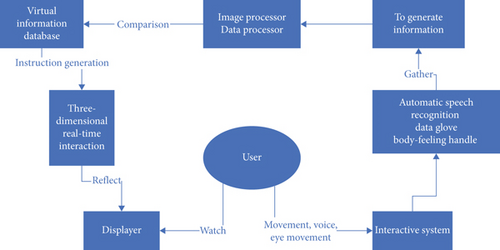
In Formula (3), R represents the number of trainers in the virtual scene. For the effective segment in a badminton training video, we use this formula to fit the virtual and actual speed, as shown in Figure 2.
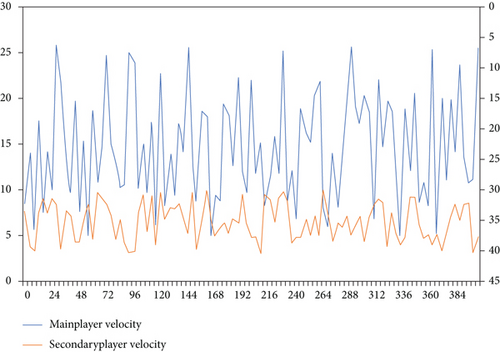
Finally, at the level of credibility 0.99, we can obtain the test accuracy of perspective classification under different training models of perspective classification, see Figure 3 for details. From Figure 3, we can see that the accuracy of the model under different sample numbers is maintained at about 97.3-98.4%, without obvious changes and fluctuations. The accuracy of our model is independent of the number of samples and the accuracy of our model.
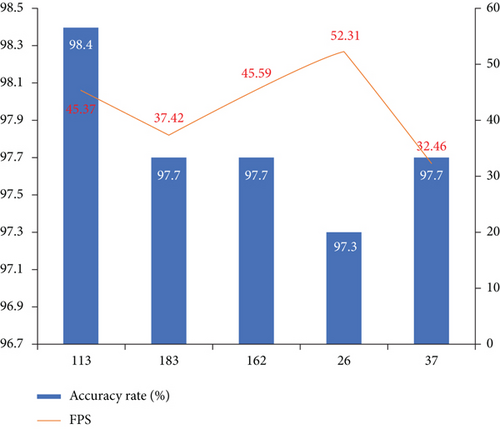
After determining the effective segment analysis of badminton training in the virtual image, we found that in order to realize the automation of all effective segment analysis in the whole video, and we need to enhance the connectivity from the previous data end to the next data end. This step can first locate the badminton trainer’s hitting action in the time domain, and the effective segments of the whole video are automatically extracted according to the located action time domain. Because the most important action in badminton training is to wave the arm to serve and receive the ball, the judgment of this action directly affects the overall situation of badminton teaching. At the same time, the action also has large fluctuations, which is easier for the camera to grasp. The above provides objective reasons and data support for our decision to use the amplitude change of the arm as the time-domain positioning element of video extraction. Finally, we decided to realize the automation of video effective segment analysis by positioning the amplitude change of the arm.
After the data cleaning, we can use the virtual image technology to automatically capture the effective video clips. We test a video containing six effective clips and count the action amplitude of the arm where the badminton racket is located and the action amplitude of the arm where the nonbadminton racket is located, respectively. The specific results are shown in Figure 4.
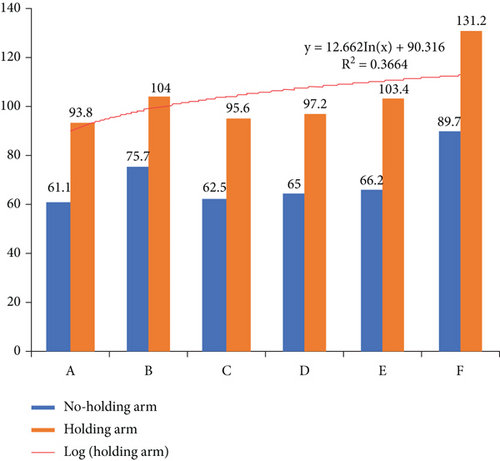
We can see that in the six clips, the movement range of the arm without holding the badminton racket is obviously smaller than that of the arm holding the racket, which is consistent with the actual situation of badminton. The arm used to serve and receive the ball is the generator of the action, while the other arm does not bear the action of serving and receiving the ball, but only plays the action of maintaining balance. Therefore, the action range of the arm without holding the badminton racket is small, which also shows that the result is more accurate.
Finally, we compare the accuracy of the virtual image technology proposed in this paper with the traditional image technology. The results show that the accuracy of each model increases gradually with the increase of the brightness of the virtual image. However, the accuracy of the model based on virtual image technology proposed in this paper remains the first from beginning to end, which also proves that the model based on virtual image technology proposed in this paper performs well. The specific trend is shown in Figure 5.
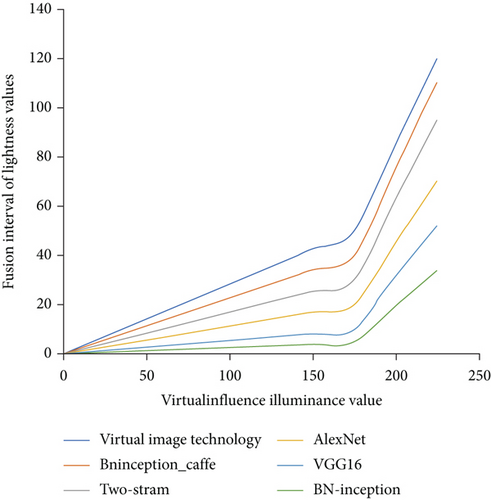
4. Result Analysis and Discussion
After the theoretical model is determined, we continue to explore the specific role of the model in efficient badminton teaching. We hope to verify the difference between the teaching effect of college students after experiencing the teaching of virtual image technology equipment and the traditional school method. First, we load the badminton training model based on virtual image technology proposed in this paper into the portable virtual image equipment. Considering the objective environment such as frequent exercise in the badminton teaching environment, we finally choose wearing VR glasses as the virtual image technology teaching environment. Students can enter the virtual classroom through wearing VR glasses containing badminton teaching applications to carry out badminton teaching and training. The specific scene is shown in Figure 6.
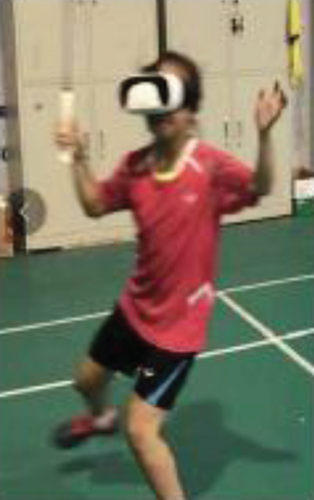
In the specific experiment, we randomly selected 30 college students to use virtual image technology for teaching. The results show that the students using virtual image technology have greatly improved their badminton action standards and enthusiasm. Among them, the moving distance of the experimental group is 24% higher than that of the control group, and the data difference between the two groups is significant at the level of confidence 0.05. Therefore, we can think that virtual image technology has a significant positive effect on efficient badminton teaching. In addition, we investigated the self perception of 30 students. It is found that the use of virtual image technology effectively improves students’ interest in badminton learning and enhances students’ self-confidence in physical training. In the self-evaluation of the effectiveness of virtual image technology, only 2 of the 30 students considered it invalid, and the self-evaluation rate of effectiveness reached 93.3%. The specific results are shown in Figure 7.
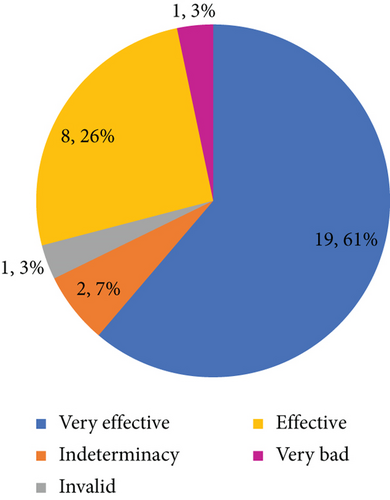
5. Conclusion
- (1)
Starting from the current situation of physical education in China, combined with the background of the reform of modern educational methods and modern educational equipment, this paper discusses the application of virtual image as a modern technology in physical education in China. This paper selects the representative badminton items in China’s physical education for analysis
- (2)
The traditional algorithm is improved, the effective segmentation and recognition algorithm of virtual image technology in motion capture are optimized, the improved virtual image technology is combined with virtual reality glasses, and the accuracy of the virtual image technology proposed in this paper is compared with that of the traditional image technology. The accuracy of the virtual image technology proposed in this paper is always kept in the first place. Practical application in badminton teaching in colleges and universities
- (3)
Compared with traditional badminton teaching, students’ level and enthusiasm of badminton have been greatly improved after using virtual image technology. The moving distance of the experimental group was 24% higher than that of the control group, and the data difference between the two groups was at the confidence level of 0.05. The use of virtual image technology effectively improves students’ interest in learning badminton, enhances students’ self-confidence in physical exercise, and significantly improves students’ learning enthusiasm and learning efficiency
Conflicts of Interest
The authors declare that they have no conflicts of interest.
Acknowledgments
The authors would like to show sincere thanks to those techniques who have contributed to this research.
Open Research
Data Availability
The figures used to support the findings of this study are included in the article.




